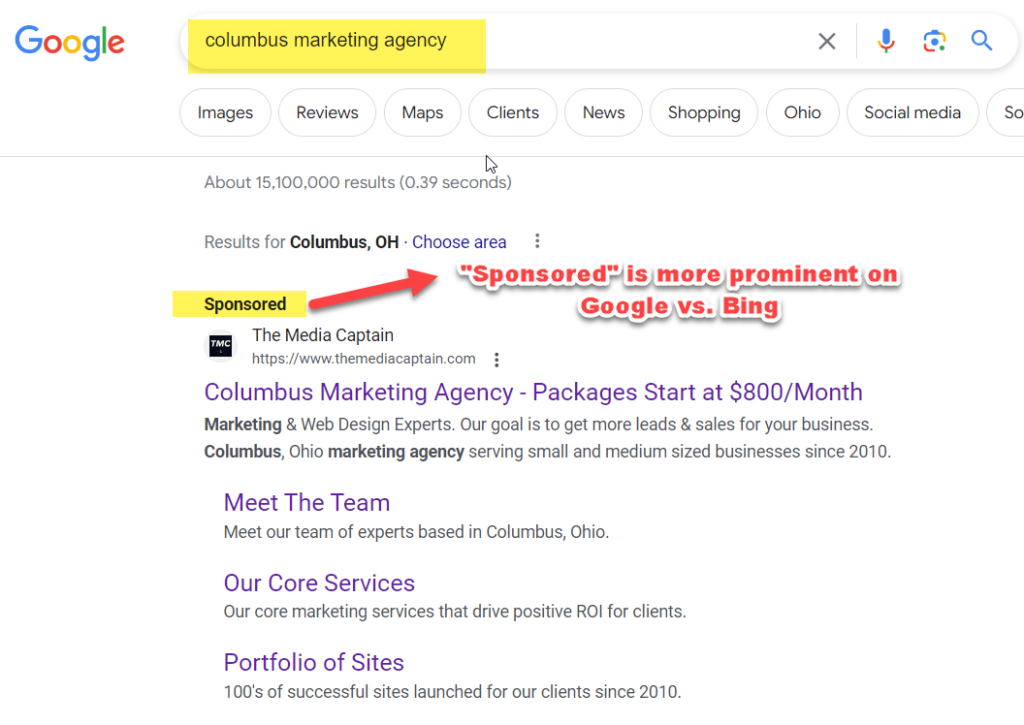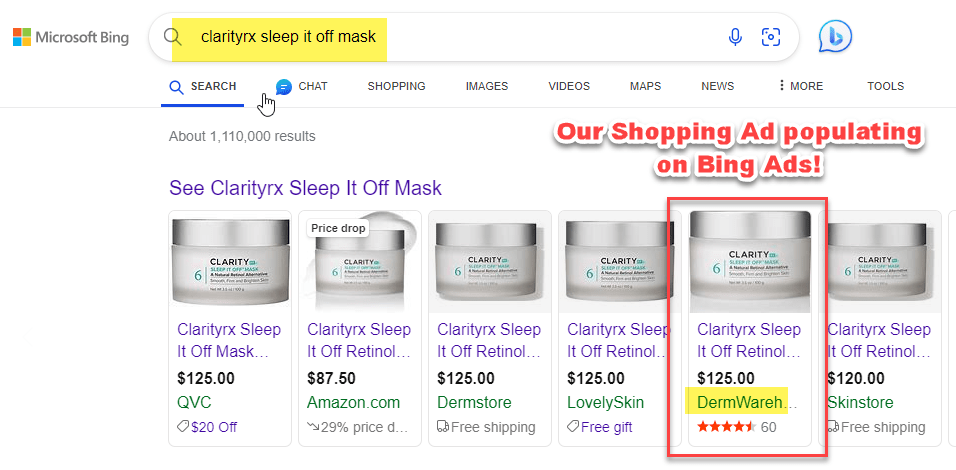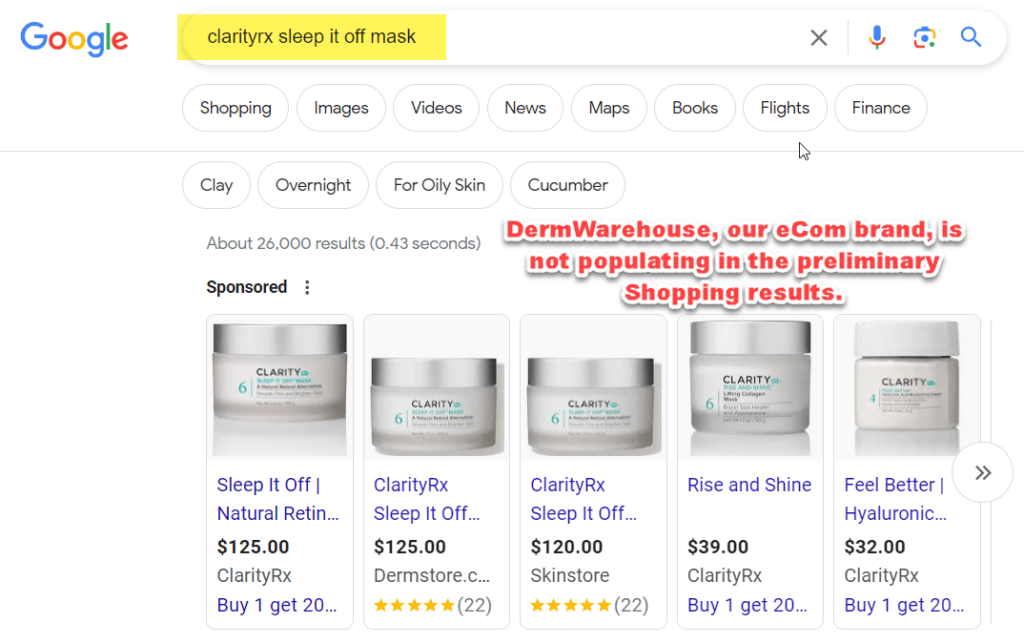Table of Contents
- 1 Don’t Overlook Bing for Advertising
- 2 Our Experience with Microsoft Advertising (Formerly Bing Ads)
- 3 Benefits Of Advertising on Bing
- 3.1 Less Competition
- 3.2 Lower Cost Per Click
- 3.3 Higher Income Customer, Higher Conversion Rate
- 3.4 Riding The ChatGPT Wave
- 3.5 Easy To Set-Up Microsoft Ads
- 3.6 Harder To Decipher Ad Vs. Organic On Bing
- 3.7 Great For Ecommerce
- 3.8 Access to Different Networks
- 3.9 Not Knowing The Difference Of Google Vs. Bing
- 4 Downsides to Advertising on Bing
- 5 In Closing
Don’t Overlook Bing for Advertising
Google dominates the search engine market share, with 79% visibility, whereas Bing has 12% [source]. Since Bing receives less exposure, advertisers flock to Google, and Bing tends to get overlooked.
There are many great benefits to advertising on Bing and leveraging this as a complimentary ad platform to Google. Bing Ads can help your business achieve a lower cost per click, a higher conversion rate, and a better return on investment. Let me explain to you how to best leverage Bing Ads to your advantage.
Our Experience with Microsoft Advertising (Formerly Bing Ads)
Our agency is unique because we work with hundreds of clients and own a seven-figure eCommerce brand in DermWarehouse. Bing Ads has been a superstar for our eCommerce business, consistently outperforming Google’s ROAS (return on ad spend). Once we started to see the benefits of Bing for our own company, it was easy to start pitching this to other clients. We actively manage millions of dollars on Bing Ads, so we have experience on this platform.
Related Blog: What is a Good Return on Ad Spend
Benefits Of Advertising on Bing
Less Competition
- Google processes over 8.5 billion searches per day [source].
- Bing sees over 900 million searches per day and 27 billion web searches per month [source].
- While Bing has a much smaller market share, many searches are still taking place on Bing.
- Less competition drives down the average cost per click (more on this in the next section).
I’ve always firmly believed in being a big fish in a small pond. The same mantra holds for Bing advertising. Despite having less market share, it’s still the second-largest search engine in the world, with plenty of searches happening each day at a lower cost per click.
Related Blog: How to Create Conversion Tracking on Bing Ads
Lower Cost Per Click
As more advertisers bid for ad placements, the demand increases, and the cost-per-click rises [source]. Since there are fewer advertisers on Bing versus Google, naturally, the cost per click will decrease. Below are statistics that show how Bing is a less expensive option than Google.
- The average cost-per-click on Bing Ads can be up to 70% lower than Google Ads [source].
- In a test run by SpyFu, Google’s average CPC was $2.69 vs. Bing’s $1.54 [source]
- DermWarehouse’s Bing Shopping averages a cost per click of $0.33 compared to $0.48 for Google.
Higher Income Customer, Higher Conversion Rate
Bing’s user demographic represents higher age groups and income levels [source]. When you advertise on Bing, you reach someone with more disposable income, which benefits advertisers. About 35% of the Bing Network has a household income of over $100,000, and almost 50% has a household income of $75,000 or more.
It’s worth noting that Bing has 34% of the desktop search engine market share worldwide [source]. In the United States, desktops convert at 3.99% while mobile devices convert at 1.22% [source]. This further validates that your likelihood of converting new customers improves when you advertise on Bing.
Riding The ChatGPT Wave
ChatGPT was the fastest-growing internet app of all time, amassing over 100 million users in just two months [source]. Microsoft invested $10 billion into ChatGPT and, in return, receives 75% of OpenAI‘s profits until it recoups its initial investment. After hitting that threshold, Microsoft would have a 49% stake in OpenAI [source].
Microsoft, of course, owns Bing. There are many ways AI will be incorporated into search. When you advertise on Bing, you get to piggyback on all of the momentum of ChatGPT and the extra eyeballs it will bring to Bing.
Easy To Set-Up Microsoft Ads
The ads interface on Microsoft Ads is very similar to Google’s. You can easily import your campaign structure from Google to Bing in minutes. The image below illustrates how easy it is to import your campaign to Bing with the click of a button.
When you advertise on Bing, there’s not much of a learning curve if you’re already familiar with Google Ads, as the structure is very similar.
An import button allows you to import campaigns from Google to Bing.
Harder To Decipher Ad Vs. Organic On Bing
Bing is sneaky when highlighting the paid ads vs. organic placements. Most people could not tell the difference between the two.
The example below highlights the difference between an Ad and an Organic result. On Google, it’s more clear when there is paid placement versus an organic search result.
This is an advantage for advertisers, considering more than 90% of people skip over the paid ads.
BING EXAMPLE:

GOOGLE EXAMPLE:
 Great For Ecommerce
Great For Ecommerce
Just like Google, Bing has shopping advertisements called Microsoft Shopping. The products you serve derive from Microsoft Merchant Center.
Since most eCommerce brands target a nationwide audience, there is an excellent opportunity for customer acquisition on Bing via shopping ads. Unlike a local business that may have to worry about a lack of search volume on Bing, when you target a product nationally, it will likely reach a large audience.
The example below shows that our Shopping Ad for “ClarityRX Sleep It Off Mask” populates on Bing, where it does not appear on Google. The reason for this because there’s less competition on Bing. Despite there being less volume, we’re receiving more exposure!
ECOMMERCE SEARCH ON BING

ECOMMERCE SEARCH ON GOOGLE:
 Access to Different Networks
Access to Different Networks
In addition to Bing, Microsoft owns Yahoo! and AOL [source]. Bing rebranded to Microsoft Ads in 2019 because advertisements serve all three networks (Bing, Yahoo!, and AOL).
Yahoo! is the third largest search network in the world, and AOL is the 9th. This also allows for your display and retargeting advertisements on Bing to reach a wide variety of sites.
Not Knowing The Difference Of Google Vs. Bing
Many people don’t realize they are searching on Bing versus Google.
Bing is set as the default browser on all Microsoft computers. It’s estimated that there are more than 1 billion Windows-powered PCs! This results in a lot of searches taking place on Bing.
When many people open their default web browser, Bing populates. Someone searches Bing just like they would on Google. If your advertisement populates, you can capitalize on this advertisement to acquire new customers.
Downsides to Advertising on Bing
The biggest downside to Bing ads is that this platform likely cannot stand alone with a substantial budget. Bing likely would not bring you enough traffic or new customers to be your sole advertising platform. It’s a great appetizer, whereas Google is the entrée.
Another downside to Bing is that their automated bidding strategies do not work well. Most of the campaigns we’re running on Google use automated bidding strategies such as Target ROAS or Maximize Conversions. We’ve extensively experimented with automated bidding strategies on Bing, and this platform does not stack up to Google. Whenever we import our campaigns to Bing, we use a manual CPC strategy. This means we must put in more work to manage these campaigns since the bidding is not automated.
In Closing
If you only advertise on Google, you should highly consider Bing Ads. This platform will help you better diversify while potentially driving a lower cost per click, lower cost per conversion, and higher average order.
We’ve benefited immensely from Bing Ads for our clients and our in-house eCommerce brand, so we recommend giving it a shot.
If you have any questions on paid advertisements or Bing, contact The Media Captain!



